
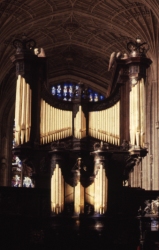
The Seventeenth Century
|
|
Introduction |
The Organ before
1650 |
Dispositions before 1650
|
Cases before 1650
After 1660 | Cases after 1660 | Photograph | Review Quiz |
|
IntroductionThe history of the organ in England is a long one, dating back to the tenth century at least. Sources from the late middle ages through the Renaissance give ample evidence of organs in the British Isles, particularly in association with monastic institutions, larger churches and cathedrals, and the royal chapel. Yet, several major events of the sixteenth century leave us with very little evidence in terms of surviving instruments. In fact, from the early sixteenth century through the third quarter of the seventeenth century, a succession of political upheavals and changes in relationship between church and state, and even a major disaster contribute to the failure of many early organs to survive.
As pointed out below, the second period of organ-building in seventeenth-century England allowed the absorption of two other schools of influence: French and North European.
|
|
Introduction |
The Organ before
1650 |
Dispositions before 1650
|
Cases before 1650
After 1660 | Cases after 1660 | Photograph | Review Quiz |
The Organ in England before 1650From all evidence that remains in written descriptions and fragmentary sources, the organs that were built in the early part of the seventeenth century continued the practices of earlier English builders. In summary, we may say that the typical English organ before about 1650 129
The most important builder of organs in England in the first half of the seventeenth century was Thomas Dallam and his son Robert, who provided instruments in such diverse locations as King's College, Cambridge, Westminster Abbey, and Durham Cathedral. Although no complete instrument survives, records indicate that their organs were well-made, well-respected, and consistent in disposition.
|
| Introduction
| The
Organ before 1650 | Dispositions
before 1650 | Cases before
1650 After 1660 | Cases after 1660 | Photograph | Review Quiz |
Dispositions before 1650The organ Robert Dallam built for York Minster in 1632 may be seen as typical of an English organ before 1650. 131 |
| Great Organ | Chair Organ | |||
|---|---|---|---|---|
| Open Diapason | 8 | Diapason | 8 | |
| Open Diapason | 8 | Principal | 4 | |
| Stopped Diapason | 8 | Flute | 4 | |
| Principal | 4 | Small Principal | 2 | |
| Principal | 4 | Recorder | 8? 2? | |
| Twelfth | 2 2/3 | |||
| Small Principal | 2 | |||
| Recorder | 2 | |||
| Two and Twentieth | 1 | |||
|
It is not uncommon to encounter ambiguities in early organ contracts, and the Recorder on the Chair organ is one of those cases in which it is difficult to determine what actual pitch level is described. The notation in the contract reads "... one recorder of tynn, unison to the voice."132 This might refer to a different pitch level for the stop (as in 8' Choir pitch, instead of organ pitch) or indicate unison pitch to the preceding stop or "voice" in the list - - a 2' Principal. Regardless of the intent of this one item, we see an instrument that
 The appearance
of two 8' Open Diapasons on the Great is explained by the typical placement
of an English organ on the Choir Screen. The diagram to the right shows
the broad outlines of the floor plan of a typical English organ placement.
The red rectangle is the outline of the choir screen, which effectively
separated the Choir from the Nave. The organ was placed above the screen,
from which position it actually had two façades: one facing the
Nave, one facing the Choir. The Chair Organ was normally on the side of
the screen that faced the Choir. The appearance
of two 8' Open Diapasons on the Great is explained by the typical placement
of an English organ on the Choir Screen. The diagram to the right shows
the broad outlines of the floor plan of a typical English organ placement.
The red rectangle is the outline of the choir screen, which effectively
separated the Choir from the Nave. The organ was placed above the screen,
from which position it actually had two façades: one facing the
Nave, one facing the Choir. The Chair Organ was normally on the side of
the screen that faced the Choir. 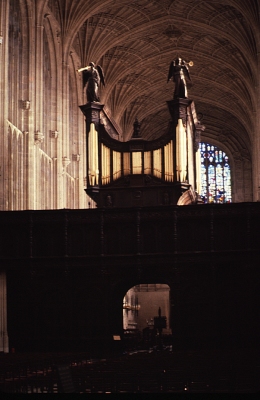 The photograph to the left is of the organ in King's College, Chapel, Cambridge. This is a view
of the organ from the side of the nave, where one of the Open Diapasons is used in the pipe
display of the façade.
134
The photograph to the left is of the organ in King's College, Chapel, Cambridge. This is a view
of the organ from the side of the nave, where one of the Open Diapasons is used in the pipe
display of the façade.
134
|
| Introduction
| The
Organ before 1650 | Dispositions
before 1650 | Cases before
1650 After 1660 | Cases after 1660 | | Photograph | Review Quiz |
Appearance before 1650
|
| Introduction
| The
Organ before 1650 | Dispositions
before 1650 | Cases before
1650 After 1660 | Cases after 1660 | Photographs | Review Quiz |
Builders and Influences after 1660You might have to look at the list in the introduction to be reminded, but it is important to remember that organ building came to a halt in England from 1642 until 1660. During that time, many builders - - including Robert Harris - - left for the continent. It is not surprising, then, that not long after the monarchy was restored these builders and their descendants returned to England with new ideas for instruments.
"Father" Smith (known by that nickname during his lifetime) was of Dutch or German descent, and appears to have been active in Holland before coming to England. He and Renatus Harris were in competition for some years, each of them striving for the better contracts, occasionally indulging in some underhanded practices. Their rivalry culminated in the "Battle of Organs" in the 1680's, in effect a competition for winning a contract for a new organ to be built in the Temple Church, London. (Just so you'll know, Father Smith won the "battle" and got the contract.) Although little remains of their work today, reports from contemporaries and even from writers in the nineteenth century indicate a high degree of success on the part of both men. With the work of these two men, and of others less well known today, changes began to be made in the construction of the organ in England, including
|
| Introduction
| The
Organ before 1650 | Dispositions
before 1650 | Cases before
1650 After 1660 | Cases after 1660 | Photograph | Review Quiz |
Appearance after 1660There are no surviving intact organs by either Renatus Harris or Father Smith. Although some pipework is intact in smaller instruments, we must often rely on later reports, even from the nineteenth century, to have an idea about how their larger organs sounded. In contrast to the situation with pipework from the late seventeenth century, some cases survive, so we do have an idea about the apearance of these organs.
By the way, the organ now in the case was completed by Hill, Norman
& Beard in 1964. It contains pipes from the Smith organ in seven stops
of the principal chorus of the Great and four stops of the Choir.
Smith died in 1708, before the organ for Trinity College was finished. It was completed by Christopher Schrider, Smith's son-in-law and successor in the business. Schrider also added a swell division to the instrument in 1715, but that's an innovation in English organs that you'll read about on another page.
|
| Introduction
| The
Organ before 1650 | Dispositions
before 1650 | Cases before
1650 After 1660 | Cases after 1660 | Smith's Organ for St. Paul's | Photographs | Review Quiz |
| Introduction
| The
Organ before 1650 | Dispositions
before 1650 | Cases before
1650 After 1660 | Cases after 1660 | Photograph | Review Quiz |
PhotographsYou can see an enlargements of the photograph of King's College Chapel on this page. You will have to use your browser's "back" button to return to this page.
|
© 1999 James H. Cook
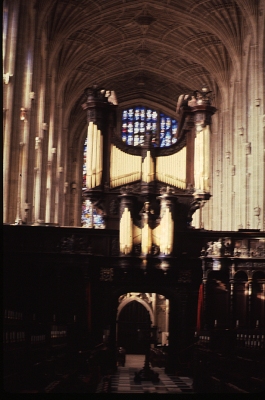 This view is of the same organ as seen from the choir. The other Open
Diapason appears in the façade of the main case, while the "Chair organ" has its own
Diapason and Principal ranks used in its façade.
This view is of the same organ as seen from the choir. The other Open
Diapason appears in the façade of the main case, while the "Chair organ" has its own
Diapason and Principal ranks used in its façade.
 The
photographs above also bring up the matter of the visual design of the English organ. From
surviving sources, including some drawings and paintings of instruments built before 1700, the
preferred façade design and pipe layout is best described by the term "receding
perspective."
The
photographs above also bring up the matter of the visual design of the English organ. From
surviving sources, including some drawings and paintings of instruments built before 1700, the
preferred façade design and pipe layout is best described by the term "receding
perspective."  The organ in St. James
Piccadilly (London) was built by Renatus Harris and completed in 1688. As you can see in the photograph
to the right, it has been altered since its completion. A nineteenth-century Swell box seems to grow
out
of the top of the case, making the whole instrument look a little top heavy. If you look at the
original
case and its façade, you can find some characteristics which might be continental, others English
in origin.
The organ in St. James
Piccadilly (London) was built by Renatus Harris and completed in 1688. As you can see in the photograph
to the right, it has been altered since its completion. A nineteenth-century Swell box seems to grow
out
of the top of the case, making the whole instrument look a little top heavy. If you look at the
original
case and its façade, you can find some characteristics which might be continental, others English
in origin.
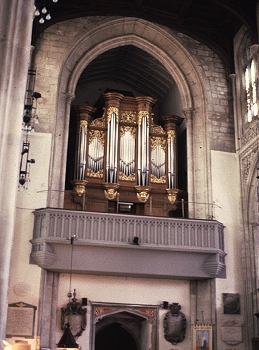 The
organs of Father Smith have several identifying characteristics, some
of which derive from cases built in the Lowlands and northern Germany.
One of the more common of these elements of visual design can be seen
in his case for the organ at Great St. Mary's (St. Mary the Great, The
University Church) in Cambridge. The organ was completed in the 1690's
and was placed in this deep gallery about a century later. The most
noticeable characteristic in the façade is the two tall central
towers. Organs from northern Europe had been built with a single central
tower for two centuries when Smith built this case. Two towers in the
center of the façade are found in cases built by other people
during this time, but they are most noticeable and successful in cases
built by Father Smith. Another point to notice is the extension of the
case to the sides at the impost level, another characteristic derived
from practices in northern Europe.
The
organs of Father Smith have several identifying characteristics, some
of which derive from cases built in the Lowlands and northern Germany.
One of the more common of these elements of visual design can be seen
in his case for the organ at Great St. Mary's (St. Mary the Great, The
University Church) in Cambridge. The organ was completed in the 1690's
and was placed in this deep gallery about a century later. The most
noticeable characteristic in the façade is the two tall central
towers. Organs from northern Europe had been built with a single central
tower for two centuries when Smith built this case. Two towers in the
center of the façade are found in cases built by other people
during this time, but they are most noticeable and successful in cases
built by Father Smith. Another point to notice is the extension of the
case to the sides at the impost level, another characteristic derived
from practices in northern Europe.
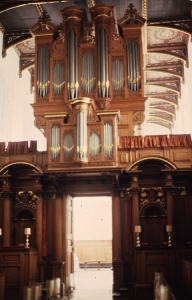 A few years later
Smith started a new instrument for Trinity College, Cambridge, the organ in the photograph to the right.
The Chair case is from an earlier instrument, and you can see that Smith did not try to match it. The
central towers are separated here by single-story flats, just as they are in the case for Great St.
Mary's, shown above. The extra width of the case at the impost level is even more prominent here than
in the Great St. Mary's case, while the double central towers distinguish it from cases being built in
northern Europe about this time.
A few years later
Smith started a new instrument for Trinity College, Cambridge, the organ in the photograph to the right.
The Chair case is from an earlier instrument, and you can see that Smith did not try to match it. The
central towers are separated here by single-story flats, just as they are in the case for Great St.
Mary's, shown above. The extra width of the case at the impost level is even more prominent here than
in the Great St. Mary's case, while the double central towers distinguish it from cases being built in
northern Europe about this time.